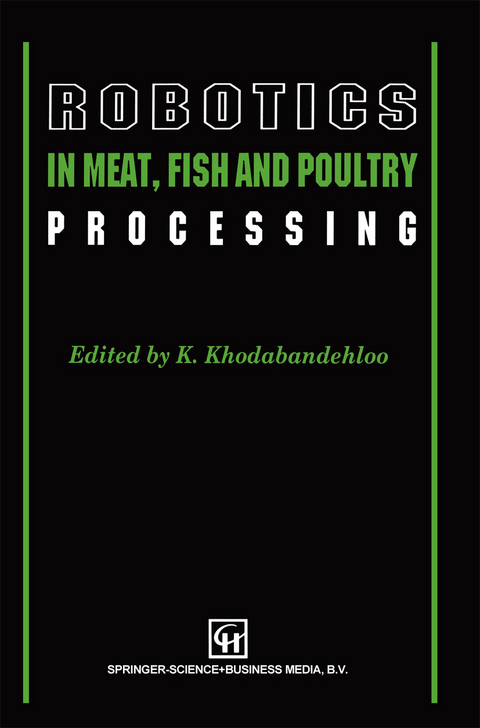
Robotics in Meat, Fish and Poultry Processing
Springer-Verlag New York Inc.
978-1-4613-5888-6 (ISBN)
1 Capabilities and potential of robotics.- 1.1 Robotic technology and capability.- 1.2 Current robotic devices in use in the food sector.- 1.3 Production of primal cuts from carcasses.- 1.4 Concluding remarks.- References.- 2 Fish processing using computer vision and robots.- 2.1 Introduction.- 2.2 Current procedures in fish processing.- 2.3 Implementation aspects.- 2.4 Robotic and vision systems in use for fish processing.- 2.5 New applications and technological needs.- 2.6 Concluding remarks.- References.- 3 Robotics and the poultry processing industry.- 3.1 Introduction.- 3.2 The typical poultry processing operation.- 3.3 Issues impacting the potential for robotics in poultry processing.- 3.4 Evolution of automation in processing plants.- 3.5 Traypack workcell.- 3.6 Parts transfer/loading workcell.- 3.7 Vision for quality and machine control.- 3.8 Future directions and development needs.- References.- 4 Robotic packaging of poultry products.- 4.1 Introduction.- 4.2 The end-effector.- 4.3 The vision system.- 4.4 Vision system software.- 4.4.1 Training and recognition.- 4.5 Robot system integration.- 4.6 Poultry weight saving simulation.- 4.7 Conclusions.- Acknowledgements.- References.- 5 Robotic cutting of beef and deboning.- 5.1 Introduction.- 5.2 Robotic butchery system requirements.- 5.3 Butchery system operation scheme.- 5.4 Further work.- 5.5 Conclusions.- Acknowledgements.- Appendix 1: Cutting scheme definition.- Appendix 2: Forequarter measurement points.- References.- 6 Automation in the production of pork meat.- 6.1 Processes in pig carcass production and handling.- 6.2 Current trends in mechanisation and automation in the pork industry.- 6.3 Potential for improving quality by automation.- 6.4 Automatic grading system and description of a current system in use.- 6.5 Information management system for slaughterhouse companies.- 6.6 Future potential for robotics in pig slaughtering and cutting.- 146 Reference.- 7 The grading of meat carcasses.- 7.1 Introduction.- 7.2 Automated grading of meat carcasses.- 7.3 Methods of instrumental grading of pig carcasses.- 7.4 Methods of instrumental grading of beef and sheep carcasses.- 7.5 Video image analysis and carcass grading.- 7.6 Automation.- 7.7 Future developments.- References.- 8 Automated analysis of meat quality.- 8.1 Introduction.- 8.2 Trends in quality development.- 8.3 Market trends.- 8.4 Requirements and techniques for quality control of pork.- 8.5 Functional requirements.- 8.6 State-of-the-art techniques.- 8.7 Integration between slaughtering and measuring processes.- 8.8 A robotic analysis centre integrated with sampling in a pork plant.- 8.9 Practical experience and system development.- 8.10 Future needs in automated pork quality control.- 8.11 Integration and limitations.- 9 Flexible assembly and packaging automation in food production— study tour report.- 9.1 Introduction.- 9.2 Characteristics of the food industry.- 9.3 Consumer trends.- 9.4 Trends in global food manufacturing.- 9.5 Elements of industrial scale food manufacturing systems.- 9.6 Research and development.- 9.7 Study tour report—period April to December 1991.
| Zusatzinfo | XII, 214 p. |
|---|---|
| Verlagsort | New York, NY |
| Sprache | englisch |
| Maße | 155 x 235 mm |
| Themenwelt | Informatik ► Theorie / Studium ► Künstliche Intelligenz / Robotik |
| Technik ► Elektrotechnik / Energietechnik | |
| Technik ► Lebensmitteltechnologie | |
| Technik ► Maschinenbau | |
| ISBN-10 | 1-4613-5888-4 / 1461358884 |
| ISBN-13 | 978-1-4613-5888-6 / 9781461358886 |
| Zustand | Neuware |
| Haben Sie eine Frage zum Produkt? |
aus dem Bereich


